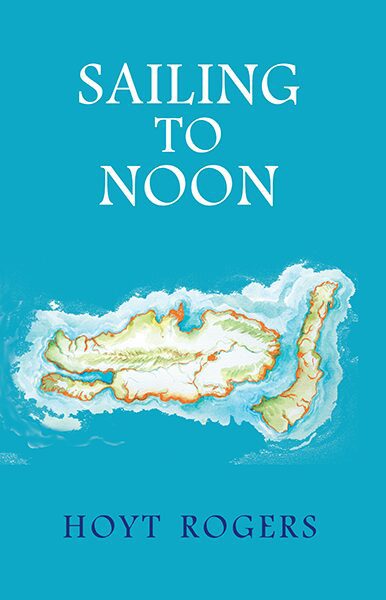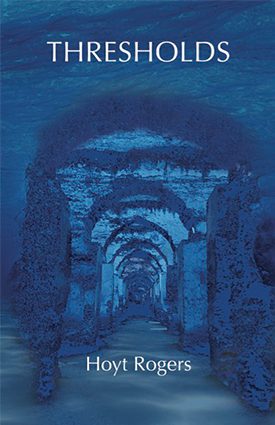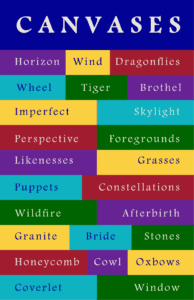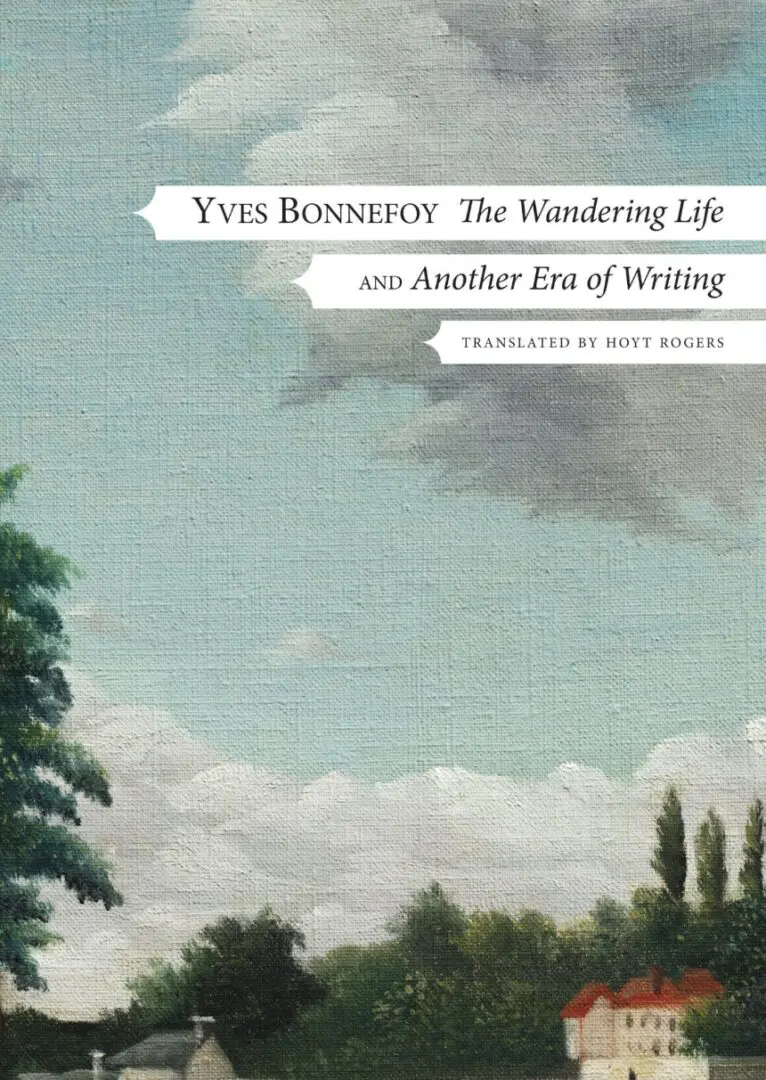
Writer, Translator, Scholar, Internationalist
RECENT
Sailing to Noon
by Hoyt Rogers
In a lush Caribbean setting, Sailing to Noon depicts a colorful range of characters. Despite her travels throughout the world, Chiara marvels at Canuba, where “magic realism” is everyday life. Amado, her pansexual lover, immerses her in its eclectic culture, natural wonders, and buoyant sensuality. Enthralled by her island reverie, she veers off course when disaster strikes: now she must face the darker side of paradise.
Winner of the 2025 Independent Press Award for Hispanic/Latin Fiction, the 2025 IPA Distinguished Favorite Awards for Literary Fiction and for Book Cover Design, and the 2024 NYCBB Distinguished Favorite Award for LGBTQ Fiction
If you missed out on a wild, sexy adolescence or if your friends bore you, read Sailing to Noon. These people—so vital, so different from each other—are the most exciting you’ll ever meet, and Hoyt Rogers holographs them into pulsing existence. Did I mention he’s the world’s greatest ventriloquist and can capture the speech of a Sicilian aristocrat or a Caribbean beefcake or a dozen other dialects? You should put this book in a tightly sealed drawer; otherwise, it’s so alive it might run away.
—Edmund White
By the end of Sailing to Noon, the reader has a strong understanding of the class, color, and sexual divides and overlaps that roil the island with their many historical complexities. I loved the creation myth and the discussion of it at the center of the novel, as well as the beautiful prose given over to what, for lack of a better term, we call “nature writing,” as if we aren’t nature: we are, as Hoyt Rogers underlines. The whale-watching episodes are wondrous. As to Chiara, Amado, Lamia, and their friends, all the characters are deftly drawn throughout. I particularly appreciated Luz Divina, who grows as Chiara slowly penetrates her mysterious form of possessiveness and love—reading the signs. The cat story is brilliant. I really felt this book: I entered its geography, saw and smelled, and moved in it, which is a tribute to its vivid intimacy. But the novel has important dollops of irony and the ludicrous, too, without which it would lose its comedic edge and wisdom.
—Siri Hustvedt
On an expansive canvas, Hoyt Rogers has portrayed a sense of life that is freewheeling and all-forgiving. Rich and multifarious, Sailing to Noon has enormous vitality and texture: it is a big performance—the epic myth of Canuba. I greatly admire the atmospherics, tonal shifts, and drive of this book.
—Jonathan Galassi
Rogers is masterly at building and elaborating upon a community of salty islanders, all set in melodramatic motion or caught in moments of erotic impulsivity. Sailing to Noon benefits greatly from multiple narrators who offer their vibrant perspectives. By the time the rollicking conclusion arrives, it’s evident there are many more tales to tell of this island: Canuba becomes a character in and of itself. Rogers employs satire, sex, and drama in wondrous ways.
—KIRKUS REVIEWS
The Caribbean Trilogy
Though it stands fully on its own, Sailing to Noon is the first volume of The Caribbean Trilogy, three novels by Hoyt Rogers (with guidance from Artemisia Vento and Frank Báez). The second and third books, Midnight at Sea and Return to Day are forthcoming; a sequel is also in preparation, The Caribbean Farewell.
Published by Spuyten Duyvil Press, Available from the publisher, Amazon, bookshop.org, and other outlets.
Thresholds
These oceanic meditations on the vicissitudes of existence— love, transience, the relentless immortality of recurrence—are piercing, hypnotic, and deeply moving.
—Jonathan Galassi
Hoyt Rogers has crafted a book of paradox and mystery unlike any other I have encountered in quite a few years, each page— each line—a doorway into a world oddly familiar and utterly new.
—Daniel Lawless
Winner of the 2025 Independent Press Award Distinguished Favorite Award for Poetry
His highly personal relationship with nature, man-made objects, and the unknown worlds around us brings us closer to ourselves ... as if every single thing has lived for the word that’s about to name it.
—Paul Roth
With this magnificent book, Hoyt Rogers has come of age as a significant writer... He has enriched the language of poets like Oppen, Lowell, and Heller, who would all salute him.
—Anthony Rudolf
With precise imagery, the author benevolently recalls those who have crossed his path.... Thresholds chronicles an ongoing quest for what it means to “have a life.”
—John Taylor
In Thresholds, Hoyt Rogers shares a series of poems about impermanence. This collection offers musings on nature, relationships, and endings… Rogers considers how words can salvage hope, but also betray, and how silence can be a language all its own. He explores the fragile, ephemeral nature of love and the tension between connection and distance. He highlights the repetition of life, suggesting that happiness is infinitely renewable in nature and in love… Rogers’s style blends lyricism with philosophical meditation, making this an emotionally intriguing and intellectually stimulating collection. His connection to the natural world is visceral and immersive; he deftly evokes the exhilaration of love… This is an introspective collection that invites contemplation.
—KIRKUS REVIEWS
Published by MadHat Press, Available from the publisher, Amazon, bookshop.org, and other outlets.
CANVASES
A cycle of prose poems by Hoyt Rogers (Mudlark Press, 2024).
Now available as an online chapbook at
https://mudlark.domains.unf.edu/chaps/mudlark78/rogers-cover.html
OR CLICK ON CHAPBOOK COVER TO ACCESS
A Note on Canvases
These poems are the nucleus of an ongoing sequence of rectangular chunks of “painted prose.” They posit the existence of a non-binary, feminist, multiethnic, environmentalist, Hispanic-Caribbean artist who writes ekphrastic poems about her/his/their own works, and then paints over them. To some degree, the prose poems run parallel to a verse-cycle entitled Colors, which follows a similar pattern of polychrome variations.
Both the prose poems and verse-cycle are connected to passages in my forthcoming novel, Midnight at Sea, the second volume of The Caribbean Trilogy (the first, Sailing to Noon, has already appeared at Spuyten Duyvil Press). One of the main characters is a painter named Virgilio, who thinks in terms of canvases; sometimes he executes his conceptions, but often they remain suspended in his mind.
In addition to his own works, he describes plates from The Taíno Codex, an indigenous manuscript from the sixteenth century. In that apocryphal tome, one of the last Native Americans on a Hispanic-Caribbean island has created a codex similar to the well-known Aztec and Inca accounts.
In all forms—whether verse, prose poetry, or narrative—I’m exploring how an artwork can generate an ekphrastic word-scape, only to pivot back towards the visual once again. —HR
WILL:
Shakespearian Sonnets
by Marco Simonelli
translated and introduced by Hoyt Rogers
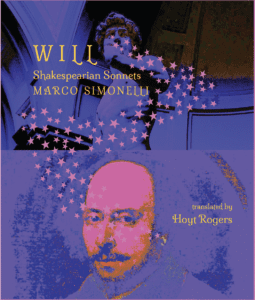
Shakespeare’s sonnets, transposed to contemporary Florence…
Marco Simonelli was born in Florence, where he lives to this day; though still in his forties, he has already published a dozen books of verse. His work has figured widely in periodicals, anthologies, and literary festivals; it has been translated into English, French, and German. Some of his titles—Good Manners (2018), Splatter Love Poems (2015), and The Lobster’s Complaint (also 2015)—reveal the mordant wit for which he is known. But this does not preclude a serious vein, poignantly felt in one of his most recent books, Anxious Litany: a subtle analysis of depression, the work draws on such classic authors as Tasso, Leopardi, and Pascoli.
Far more light-heartedly, Simonelli’s Will: 24 Sonnets (2009) pays homage to Shakespeare’s sonnets, giving them a modern Tuscan twist. As he points out in his brief prologue, the English poet often makes a pun on his own nickname, “Will” (for example, in sonnets 135 and 136). The word implies many meanings, from strong determination to Elizabethan slang for the male organ, and from lustiness in general to a formal legal testament. But Simonelli underlines a connotation that would not immediately occur to an English-speaker: the ubiquitous role of “will” as an auxiliary verb in the future tense—that horizon of uncertainty which leaves us all in a state of flux.
“Poetry that wins your heart…”
— Lello Voce
“The problem is always the soul’s salvation; the solution, here and now, is the sublime reality of a same-sex love that’s tenderly revealed.
— Rosaria Lo Russo
"These sonnets are an erotic and ironic marvel! The Bard would have loved them.”
— Elisa Biagini
YVES BONNEFOY:
THE WANDERING LIFE
and ANOTHER ERA OF WRITING
Translated and with an afterword by Hoyt Rogers
‘Bonnefoy is well known for obscuring the boundaries between verse and prose, just as he often confronts the representational issues that both vex and liberate the so-called sister arts of poetry and visual art.’
—World Literature Today
Yves Bonnefoy was an ardent voyager throughout his life. His constant journeys and sojourns abroad, from Italy and England to America and India, left an indelible mark on his oeuvre. Tellingly, he entitled one of his major books La Vie errante (1993). The Wandering Life now appears in translation for the first time to celebrate the centenary of the author’s birth. Central to his development, this work crystallizes the traveler motif as a metaphor for aesthetic exploration. It also found a new poetic technique: that symphonic interweaving of verse and prose, which characterizes the final twenty years of his creation. In a shorter but equally important companion piece, Another Era of Writing, Bonnefoy reframes the voyage as a philosophical quest, a far-reaching dialogue between language and reality.
Yves Bonnefoy (1923–2016) was one of France’s greatest poets. He received many international awards for his work. In addition to poetry and literary criticism, he published books on art history and translated over a dozen plays by Shakespeare. In 2023, the centenary of his birth, his writings appeared in the prestigious Pléiade series of French authors.
Hoyt Rogers is the author of a poetry collection, Thresholds (2023), and a study of Renaissance verse, The Poetics of Inconstancy (1998). He has published five translations of works by Yves Bonnefoy, including Rome, 1630: The Horizon of the Early Baroque (Seagull Books), which won the 2021 French-American Foundation Translation Prize for Nonfiction.
Published by Seagull Books/U of Chicago Press, Available from the publisher, Amazon, bookshop.org, and other outlets.
YVES BONNEFOY, ROME, 1630: THE HORIZON OF THE EARLY BAROQUE, followed by FIVE ESSAYS ON SEVENTEENTH-CENTURY ART; Edited, Translated, and with an Afterword by Hoyt Rogers
Winner of the 2021 French-American Foundation Prize for Translation (Nonfiction)
'In the title study of this book, Yves Bonnefoy focuses on a pivotal year in the development of the Baroque style. Richly illustrated, his Rome, 1630 reveals how a pan-European movement was born from the achievements of the Italian and foreign artists who congregated in the city during that seminal period. The five supplementary essays in the volume further explore the evolution of seventeenth-century painting, particularly in the works of Elsheimer, Caravaggio, Corona, and Poussin. In his afterword, Hoyt Rogers
pays homage to the author himself, analyzing the centrality of Baroque art to Bonnefoy's poetry and aesthetics.'
—Seagull Books
'Yves Bonnefoy's Rome, 1630 is a marvel and a triumph, in this lucid English version by Hoyt Rogers. Together with the five further essays on seventeenth-century art that accompany the main text, this work complements the aesthetic meditation of The Arrière-Pays, which I translated for Seagull some years ago. In that book, Bonnefoy concentrates on the Italian Renaissance, whereas here, he focuses on the Roman Baroque. Along the way, he pays particular attention to two foreigners who were active in the Eternal City: Adam Elsheimer and Nicolas Poussin. In his wide-ranging afterword, Rogers discusses the poet's lifelong fascination with both painters. This is a beautiful volume of fine quality and pleasantly compact despite its length; rarely has an art book been so comfortable to read. I have re-entered with joy that great "hustle and bustle at St Peter's" in 1630.'
— Stephen Romer, Oxford University, Bonnefoy translator
'I love Hoyt Rogers's afterword to Bonnefoy's remarkable study. It is very personal, freewheeling, and learnèd; the translator is released from bondage to the text. As to the original, it is Yves Bonnefoy at his most recondite and complex and requires a devoted servant, if not the slave implied by my word "bondage." I, too, am one of Bonnefoy's several devoted servants around the world, and I salute Rogers's translation of this book. As readers, writers, and translators, we were and remain inspired by Yves Bonnefoy, poet, writer on art and literature, teacher, and friend.'
– Anthony Rudolf, author, publisher, and Bonnefoy translator
'Rome, 1630 is an important meditation on art history and, above all, on the philosophy of art. The long friendship between the author, Yves Bonnefoy, and his translator, Hoyt Rogers, was extremely fruitful for both of them. When they met in Paris, the poet was writing his extensive book on the Italian Baroque, first published in 1970. Fifty years later, this outstanding translation by Rogers, combined with that of five further essays by Bonnefoy on the same subject, affords the English-speaking world insights into the very personal "intensity of gaze" of the French author. In his afterword, "Ut poesis pictura," Rogers takes the reader on a brilliantly written journey through the "cross-fertilization" of art and poetry in Bonnefoy's work.'
— Cornelia Kemp, art historian, Research Institute of the German Museum
'In 1630, Rome witnessed a breakthrough in art, an advance that intertwined with social, economic, philosophical, and scientific developments. This turning point changed Western civilization forever. Yves Bonnefoy accompanies us in exploring this shift, leading us on a poetic journey through the history of art. Not only is the translation by Hoyt Rogers masterly, recapturing the essential poetic vigor of the author, but the illustrations are also exceptional. In his afterword to the book, Rogers gives the reader an interpretative key to Bonnefoy's work that grants us an intimate and familiar vision of the author. With this addition, the volume becomes a conversation like the many Bonnefoy and Rogers exchanged over the course of their friendship. And this time, we are more than happy to participate.'
— Michele Casagrande, arts administrator, Milan
Published by Seagull Books/U of Chicago Press, Available from the publisher, Amazon, bookshop.org, and other outlets.
(Click above to continue to next page)
